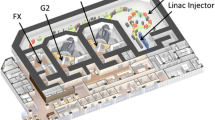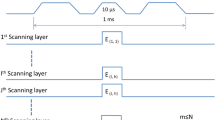Abstract
Proton FLASH therapy with an ultra-high dose rate is in urgent need of more accurate treatment plan system (TPS) to promote the development of proton computed tomography (CT) without intrinsic error compared with the transformation from X-ray CT. This paper presents an imaging mode of proton CT based on static superconducting gantry different from the conventional rotational gantry. The beam energy for proton CT is fixed at 350 MeV, which is boosted by a compact proton linac from 230 MeV, and then delivered by the gantry to scan the patient’s body for proton imaging. This study demonstrates that the static superconducting gantry-based proton CT is effective in clinical applications. In particular, the imaging mode, which combines the relative stopping power (RSP) map from X-ray CT as prior knowledge, can produce much a higher accuracy RSP map for TPSs and positioning and achieve ultra-fast image for real-time image-guided radiotherapy. This paper presents the conceptual design of a boosting linac, static superconducting gantry and proton CT imaging equipment. The feasibility of energy enhancement is verified by simulation, and results from Geant4 simulations and reconstruction algorithms are presented, including the simulation verification of the advantage of the imaging mode.






Similar content being viewed by others
References
Particle Therapy Cooperative Group (PTCOG) Collaboration. http://www.ptcog.com
E.S. Diffenderfer, B.S. Srensen, A. Mazal et al., The current status of preclinical proton FLASH radiation and future directions. Med. Phys. 49, 2039–2054 (2022). https://doi.org/10.1002/mp.15276
A. Mandapaka, A. Ghebremedhin, D. Farley et al., SU-E-J-35: clinical performance evaluation of a phase II proton CT scanner. Med. Phys. 41(6), 162 (2014). https://doi.org/10.1118/1.4888087
B. Schaffner, E. Pedroni, The precision of proton range calculations in proton radiotherapy treatment planning: experimental verification of the relation between CT-HU and proton stopping power. Phys. Med. Biol. 43(6), 1579–1592 (1998). https://doi.org/10.1088/0031-9155/43/6/016
A.M. Cormack, Representation of a function by its line integrals, with some radiological applications. J. Appl. Phys. 34, 2722–2727 (1963). https://doi.org/10.1063/1.1729798
U. Schneider, J. Besserer, P. Pemler et al., First proton radiography of an animal patient. Med. Phys. 31(5), 1046–1051 (2004). https://doi.org/10.1118/1.1690713
X.Y. Chen, R.R. Liu, S. Zhou et al., A novel design of proton computed tomography detected by multiple-layer ionization chamber with strip chambers: a feasibility study with Monte Carlo simulation. Med. Phys. 47, 614–625 (2019). https://doi.org/10.1002/mp.13909
S. Deffet, M. Cohilis, K. Souris et al., openPR—a computational tool for CT conversion assessment with proton radiography. Med. Phys. 48(1), 387–396 (2021). https://doi.org/10.1002/mp.14571
Y.J. Ma, Y. Ren, P. Feng et al., Sinogram denoising via attention residual dense convolutional neural network for low-dose computed tomography. Nucl. Sci. Tech. 32, 41 (2021). https://doi.org/10.1007/s41365-021-00874-2
K. Chen, L.B. Zhang, J.S. Liu et al., Robust restoration of low-dose cerebral perfusion CT images using NCS-Unet. Nucl. Sci. Tech. 33, 30 (2022). https://doi.org/10.1007/s41365-022-01014-0
E. Oponowicz, H. Owen, Superconducting gantry design for proton tomography, in Proceedings of IPAC2017, Copenhagen, Denmark (2017), pp. 4795–4797
W.C. Fang, X.X. Huang, J.H. Tan et al., Proton linac-based therapy facility for ultra-high dose rate (FLASH) treatment. Nucl. Si. Tech. 32, 34 (2021). https://doi.org/10.1007/s41365-021-00872-4
A. Kamal, Passage of charged particles through matter, in Nuclear Physics. (Springer, Berlin Heidelberg, 2014), pp. 1–81
S.N. Penfold, A.B. Rosenfeld, R.W. Schulte et al., A more accurate reconstruction system matrix for quantitative proton computed tomography. Med. Phys. 36(10), 4511–4518 (2009). https://doi.org/10.1118/1.3218759
D.C. Williams, The most likely path of an energetic charged particle through a uniform medium. Phys. Med. Biol. 49, 2899 (2004). https://doi.org/10.1088/0031-9155/49/13/010
R.W. Schulte, S.N. Penfold, J.T. Tafas et al., A maximum likelihood proton path formalism for application in proton computed tomography. Med. Phys. 35, 4849–4856 (2008). https://doi.org/10.1118/1.2986139
R. Schulte, V. Bashkirov, T.F. Li et al., Design of a proton computed tomography system for applications in proton radiation therapy, in Proceedings of the 2003 IEEE Nuclear Science Symposium. Conference Record (IEEE Cat. No.03CH37515), vol. 3 (2013), pp. 1579–1583. https://doi.org/10.1109/NSSMIC.2003.1352179
Y. Zhang, W.C. Fang, X.X. Huang et al., Design, fabrication, and cold test of an S-band high-gradient accelerating structure for compact proton therapy facility. Nucl. Sci. Tech. 32, 38 (2021). https://doi.org/10.1007/s41365-021-00869-z
Y. Zhang, W.C. Fang, X.X. Huang et al., Radio frequency conditioning of an S-band accelerating structure prototype for compact proton therapy facility. Nucl. Sci. Tech. 32, 64 (2021). https://doi.org/10.1007/s41365-021-00891-1
C. Wang, Z.H. Zhu, Z.G. Jiang et al., Design of a 162.5 MHz continuous-wave normal-conducting radiofrequency electron gun. Nucl. Sci. Tech. 31, 110 (2020). https://doi.org/10.1007/s41365-020-00817-3
C. Wang, J.H. Tan, X.X. Huang et al., Design optimization and cold RF test of a 2.6-cell cryogenic RF gun. Nucl. Sci. Tech. 32, 97 (2021). https://doi.org/10.1007/s41365-021-00925-8
H. Paganetti, Range uncertainties in proton therapy and the role of Monte Carlo simulations. Phys. Med. Biol. 57(11), 99–117 (2012). https://doi.org/10.1088/0031-9155/57/11/r99
J.H. Tan, W.C. Fang, Z.T. Zhao et al., Two-mode polarized traveling wave deflecting structure. Nucl. Sci. Tech. 26(4), 040102 (2015). https://doi.org/10.13538/j.1001-8042/nst.26.040102
W.S. Wan, L. Brouwer, S. Caspi et al., Alternating-gradient canted cosine theta superconducting magnets for future compact proton gantries. Phys. Rev. Accel. Beams 18, 103501 (2015). https://doi.org/10.1103/PhysRevSTAB.18.103501
R.F. Hurley, R.W. Schulte, V.A. Bashkirov et al., Water-equivalent path length calibration of a prototype proton CT scanner. Med. Phys. 39(5), 2438–2446 (2012). https://doi.org/10.1118/1.3700173
V. Giacometti, V.A. Bashkirov, P. Piersimoni et al., Software platform for simulation of a prototype proton CT scanner. Med. Phys. 44(3), 1002–1016 (2017). https://doi.org/10.1002/mp.12107
R.C. Gonzalez, R.E. Woods, B.R. Masters, Digital image processing, third edition. J. Biomed. Opt. 14(2), 029901 (2009). https://doi.org/10.1117/1.3115362
W. Yu, I. Zeng, A novel weighted total difference based image reconstruction algorithm for few-view computed tomography. PLoS ONE 9(10), e109345 (2014). https://doi.org/10.1371/journal.pone.0109345
G.A.P. Cirrone, M. Bucciolini, M. Bruzzi et al., Monte Carlo evaluation of the filtered back projection method for image reconstruction in proton computed tomography. Nucl. Instrum. Methods 658(1), 78–83 (2011). https://doi.org/10.1016/j.nima.2011.05.061
Author information
Authors and Affiliations
Contributions
All authors contributed to the study conception and design. Model design, simulation calculation and analysis were performed by Yu-Qing Yang, Xiao-Xia Huang and Jian-Hao Tan. Resources and supervision were performed by Wen-Cheng Fang, Cheng Wang, Chao-Peng Wang and Zhen-Tang Zhao. The first draft of the manuscript was written by Yu-Qing Yang and all authors commented on previous versions of the manuscript. All authors read and approved the final manuscript.
Corresponding authors
Additional information
This work was supported by the Research collaboration on Thailand new synchrotron light source facility (SPS-II) (No. ANSO-CR-KP-2020-16).
Rights and permissions
Springer Nature or its licensor (e.g. a society or other partner) holds exclusive rights to this article under a publishing agreement with the author(s) or other rightsholder(s); author self-archiving of the accepted manuscript version of this article is solely governed by the terms of such publishing agreement and applicable law.
About this article
Cite this article
Yang, YQ., Fang, WC., Huang, XX. et al. Static superconducting gantry-based proton CT combined with X-ray CT as prior image for FLASH proton therapy. NUCL SCI TECH 34, 11 (2023). https://doi.org/10.1007/s41365-022-01163-2
Received:
Revised:
Accepted:
Published:
DOI: https://doi.org/10.1007/s41365-022-01163-2




